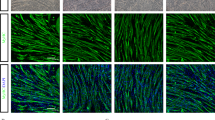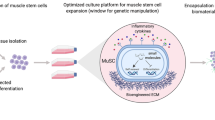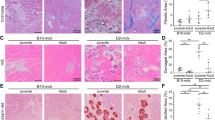Abstract
Intensive efforts have been made to develop an effective therapy for Duchenne muscular dystrophy (DMD). Although myoblast transplantation has been found capable of transiently delivering dystrophin and improving the strength of the injected dystrophic muscle, this approach has been hindered by the immune rejection problems as well as the poor survival and limited spread of the injected cells. In the present study, we have investigated whether the careful selection of donor myoblasts and host muscle for the myosin heavy chain expression (MyHCs) plays a role in the success of myoblast transfer. Highly purified normal myoblasts derived from the m. soleus and m. gastrocnemius white of normal mice were transplanted into the m. soleus (containing 70% of type I fibers) and gastrocnemius white (100% of type II fibers) of dystrophin deficient mdx mice. At several time-points after injection (10, 20 and 30 days), the number of dystrophin-positive fibers was monitored and compared among the different groups. A significantly higher number and better persistence of dystrophin-positive myofibers were observed when the injected muscle and donor myoblasts expressed a similar MyHC in comparison with myoblast transfer between host muscle and donor myoblasts that were not matched for MyHC. These results suggest that careful matching between the injected myoblasts and injected muscle for the MyHC expression can improve the efficiency of myoblast-mediated gene transfer to skeletal muscle.
This is a preview of subscription content, access via your institution
Access options
Subscribe to this journal
Receive 12 print issues and online access
$259.00 per year
only $21.58 per issue
Buy this article
- Purchase on Springer Link
- Instant access to full article PDF
Prices may be subject to local taxes which are calculated during checkout




Similar content being viewed by others
References
Hoffman EP, Brown J, Kunkel LM . Dystrophin: the protein product of the Duchenne Muscular Dystrophy locus Cell 1987 51: 919–928
Watkins SC, Hoffman EP, Slayter HS, Kunkel LM . Immunoelectron microscopic localization of dystrophin in myofibers Nature 1988 333: 863–866
Arahata K et al. Immunostaining of skeletal and cardiac muscle surface membrane with antibody against Duchenne Muscular Dystrophy peptide Nature 1988 333: 861–863
Bonilla ECE et al. Duchenne Muscular Dystrophy: deficiency of dystrophin at the muscle cell surface Cell 1988 54: 447–452
Zubryzcka-Gaarn EE et al. The Duchenne Muscular Dystrophy gene is localized in the sarcolemma of human skeletal muscle Nature 1988 333: 466–469
Acsadi G et al. Human dystrophin expression in mdx mice after intramuscular injection of DNA constructs Nature 1991 352: 815–818
Dunckley MG et al. Retroviral-mediated transfer of a dystrophin minigene into mdx mouse myoblasts in vitro Febs Lett 1992 296: 128–134
Dunckley MG, Wells DJ, Walsh FS, Dickson G . Direct retroviral-mediated transfer of dystrophin minigene into mdx mousemuscle in vivo Hum Mol Genet 1993 2: 717–723
Ragot T et al. Efficient adenovirus mediated gene transfer of a human mini-dystrophin gene to skeletal muscle of mdx mice Nature 1993 361: 647–650
Vincent M et al. Long-term correction of mouse dystrophic degeneration by adenovirus-mediated transfer of a mini-dystrophin gene Nat Genet 1993 5: 130–134
Partridge TA . Myoblast transfer: a possible therapy for inherited myopathies Mus Nerve 1991 14: 197–212
Partridge TA et al. Conversion of mdx myofibers from dystrophin negative to positive by injection of normal myoblasts Nature 1989 337: 176–179
Karpati G et al. Dystrophin is expressed in mdx skeletal muscle fibers after normal myoblast implantation Am J Pathol 1989 135: 27–32
Karpati G, Worton RG . Myoblast transfer in DMD: problems and interpretation of efficiency Mus Nerve 1992 15: 1209–1210
Tremblay JP et al. Results of a blind clinical study of myoblast transplantations without immunosuppressive treatment in young boys with Duchenne Muscular Dystrophy Cell Trans 1993 2: 99–112
Morgan JE, Pagel CN, Sherratt T, Partridge TA . Long-term persistence and migration of myogenic cells injected into pre-irradiated muscle of mdx mice J Neurol Sci 1993 115: 191–200
Beauchamps JR, Morgan JE, Pagel CN, Partridge TA . Quantitative studies of the efficacy of myoblast transplantation Mus Nerve 1994 18: (Suppl.) 261
Fan Y, Maley M, Beilharz M, Grounds M . Rapid death of injected myoblasts in myoblast transfer therapy Mus Nerve 1996 19: 853–860
Huard J et al. Myoblast transplantation produced dystrophin-positive muscle fibers in a 16-year-old patient with Duchenne muscular dystrophy Clin Science 1991 81: 287–288
Huard J et al. Human myoblast transplantation: preliminary results of 4 cases Mus Nerve 1992 15: 550–560
Huard J et al. Human Myoblast transplantation between immunohistocompatible donors and recipients produces immune reactions Transpl Proc 1992 24: 3049–3051
Huard J et al. Human myoblast transplantation in immunodeficient and immunosuppressed mice: evidence of rejection Mus Nerve 1994 17: 224–234
Huard J et al. High efficiency of muscle regeneration following human myoblast clone transplantation in SCID mice J Clin Invest 1994 93: 586–599
Huard J et al. Gene transfer into skeletal muscles by isogenic myoblasts Hum Gene Ther 1994 5: 949–958
Mendell JR et al. Myoblast transfer in the treatment of Duchenne's muscular dystrophy New Engl J Med 1995 333: 832–838
Morgan JE, Watt DJ, Slopper JC, Partridge TA . Partial correction of an inherited defect of skeletal muscle by graft of normal muscle precursor cells J Neurol Sci 1988 86: 137–147
Morgan JE, Hoffman EP, Partridge TA . Normal myogenic cells from newborn mice restore normal histology to degenerating muscle of the mdx mouse J Cell Biol 1990 111: 2437–2449
Morgan JE, Pagel CN, Sherrat T, Partridge TA . Long-term persistence and migration of myogenic cells injected into pre-irradiated muscles of mdx mice J Neurol Sci 1993 115: 191–200
Gussoni E et al. Normal dystrophin transcripts detected in DMD patients after myoblast transplantation Nature 1992 356: 435–438
Gussoni E, Blau HM, Kunkel LM . The fate of individual myoblasts after transplantation into muscles of DMD patients Nature Med 1997 3: 970–977
Kinoshita I et al. Very efficient myoblast allotransplantation in mice under FK506 immunosuppression Mus Nerve 1994 17: 1407–1415
Vilquin JT et al. Successful histocompatible myoblast transplantation in dystrophin-deficient mdx dystrophin J Cell Biol 1995 131: 975–988
Guerette B et al. Control of inflammatory damage by anti-LFA-1: increase success of myoblast transplantation Cell Trans 1997 6: 101–107
Qu Z et al. Development of approaches to improve cell survival in myoblast transfer therapy J Cell Biol 1998 142: 1257–1267
Beauchamp JR, Morgan JE, Pagel CN, Partridge TA . Dynamics of myoblast transplantation reveal a discrete minority of precursors with stem cell-like properties as the myogenic source J Cell Biol 1999 144: 1113–1122
Marconi P et al. Replication-defective herpes simplex virus vectors for gene transfer in vivo Proc Natl Acad Sci USA 1996 93: 11319–11320
Huard J et al. Gene transfer to muscle using herpes simplex virus-based vectors Neuromus Disorders 1997 7: 299–313
Huard J et al. LacZ gene transfer to skeletal muscle using a replication defective herpes simplex virus type 1 mutant vector Hum Gene Ther 1997 8: 439–452
Levatt MA, Cassam AK, Dekaban GA, Weaver LC . Analysis of a multi-mutant herpes simplex virus type 1 for gene transfer into sympathetic preganglionic neurons and a comparison to adenovirus vectors Neuroscience 1998 86: 1321–1336
Haecker SE et al. In vivo expression of full-length human dystrophin from adenoviral vectors deleted of all viral genes Hum Gene Ther 1996 7: 1907–1914
Kochanek S et al. A new adenoviral vector: replacement of all viral coding sequences with 28 kb of DNA independently expressing both full-length dystrophin and beta-galactosidase Proc Natl Acad Sci USA 1996 93: 5731–5736
Kumar-Singh R, Chamberlain JS . Encapsidated adenovirus minichromosomes allow delivery and expression of a 14 kb dystrophin cDNA to muscle cells Hum Mol Genet 1996 5: 913–921
Chen HH et al. Persistence in muscle of an adenoviral vector that lacks all viral genes Proc Natl Acad Sci USA 1997 94: 1645–1650
Xiao X, Li J, Samulski RJ . Efficient long-term gene transfer into muscle tissue of immunocompetent mice by adeno-associated virus vector J Virol 1996 70: 8098–8108
Reed Clark K, Sferra TJ, Johnson PR . Recombinant adeno-associated viral vectors mediated long-term transgene expression in muscle Hum Gene Ther 1997 8: 659–669
Fisher KJ et al. Recombinant adeno-associated virus for muscle directed gene therapy Nature Med 1997 3: 306–312
van Deutekom JCT, Hoffman EP, Huard J . Muscle maturation: implications for gene therapy Mol Med Today 1998 4: 214–220
van Deutekom JCT et al. The development of approaches to improve viral gene delivery to mature skeletal muscle Neuromus Disorders 1998 8: 135–148
Greelish JP et al. Stable restoration of the sarcoglycan complex in dystrophic muscle perfused with histamine and a recombinant adeno-associated viral vector Nature Med 1999 5: 439–443
Floyd SS et al. Ex vivo gene transfer using adenovirus-mediated full-length dystrophin delivery to dystrophic muscles Gene Therapy 1998 5: 19–30
Booth DK et al. Myoblast mediated ex vivo gene transfer to mature muscle Tissue Engin 1997 3: 125–133
Marechal G, Beckers-Bleukx G . Force-velocity relation and isomyosins in soleus muscles from two strains of mice (C57 and MNRI) Pflugers Arch 1993 424: 478–487
Guerette B et al. Lymphocytes infiltration following allo- and xenomyoblast transplantation in mdx mice Mus Nerve 1995 18: 39–51
Rando TA, Blau HM . Primary mouse myoblast purification, characterization and transplantation for cell-mediated gene therapy J Cell Biol 1994 125: 1275–1287
Brooke MH, Kaiser KK . Muscle fiber types: how many and what kind? Arch Neurol 1970 23: 369–379
Gorza L . Identification of a novel type 2 fiber population in mammalian skeletal muscle by combined use of histochemical myosin ATPase and anti-myosin monoclonal antibodies J Histochem Cytochem 1990 38: 257–265
Delp MD, Duan C . Composition and size of type I, IIA, IID/X, and IIB fibers and citrate synthase activity of rat muscle J Appl Physiol 1996 80: 261–270
Acknowledgements
We wish to thank Marcelle Pellerin and Ryan Pruchnic for their technical help and Megan Mowry, Dana Och and Sarah Martin for assistance with the manuscript. We also thank Dr LM Kunkel for the rabbit anti-dystrophin antibody (6–10). This work was supported by grants to Dr Johnny Huard from the Parent Project (USA), The Muscular Dystrophy Association (USA), the National Institutes of Health (NIH), Children's Hospital of Pittsburgh, and University of Pittsburgh.
Author information
Authors and Affiliations
Rights and permissions
About this article
Cite this article
Qu, Z., Huard, J. Matching host muscle and donor myoblasts for myosin heavy chain improves myoblast transfer therapy. Gene Ther 7, 428–437 (2000). https://doi.org/10.1038/sj.gt.3301103
Received:
Accepted:
Published:
Issue Date:
DOI: https://doi.org/10.1038/sj.gt.3301103



